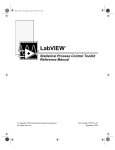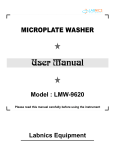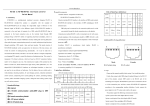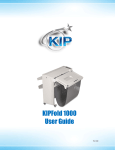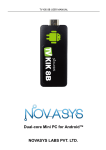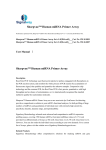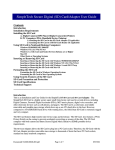Download Answers to initial set of project requirements questions: NOTE: If a
Transcript
Answers to initial set of project requirements questions: NOTE: If a question was about implementation rather than requirements, or was too broad, or I didn’t understand it, it may not be listed here. If you still are unsure of an answer, ask it in your customer face to face interview. 1. How often are reports generated, and what types are there? a. reports are generated daily. The daily reports focus on defects per unit. This is also called an audit. The other two required reports are defects per surface, and a trend of defects per unit over time. Both of these reports are generated on demand with a selectable date range (ie, for a week, a month, a year) but are typically generated weekly for defects per surface, and monthly for trend. All three reports must be generated for each of the three checkpoints. 2. Is the severity and type something the user inputs? a. yes 3. Are the tables on the QA reports static, or are the combinations variable? a. the tables are the ones that should appear each time on the daily report 4. How will the reports be delivered? a. reports need to be printed so they can be taped to the wall, but they also should be able to be reproduced on demand (ie, I might request last Thursday’s daily reports) 5. What are the major requirement differences for each plant? a. For purposes of this project, you can assume each plant has the same paint process (ie, the same checkpoints), and the same set of defect types. So the major differences are in the car models that are built at each plant. 6. How far back do you want information to be saved to the app/ how long before data is dumped? a. indefinitely 7. Who is going to be submitting the data to the app/ to the database? a. the analysts who work at the plant 8. Do you submit every time there is a stop in the conveyer belt, or just once a day? a. Don’t understand the question. The belt is continuously moving, defects are recorded as the car goes by 9. What kind of security measures should be in place? How big of a problem would it be if an unauthorized user, like somebody from a rival automotive company, got into the system to identify defects? a. unauthorized users should not be allowed to view the data. 10. How should reports be generated, after a certain number of vehicles are analyzed, when the analyst decides to, or through a different method. a. reports should be generated when the analyst decides. Though daily reports typically contain 10 units, the analyst may choose to include 15, or 20. 10 is the minimum for a good sampling. 11. Is there a set list of defects to be looked for? If so, what is the complete list? If not, how and when should the user have the option to add more? a. The list of defects will be provided in a separate document. The user should be able to add more as they discover them 12. In the weekly chart, What is the UCLx, LCLx, CP, and CPk mean? a. Those abbreviations are not important. They are artifacts of generating the trend chart. The trend chart just shows DPU over time. 13. The cars list at the top of the report is ordered? a. the order of the model list is not important 14. what will be reported if there was an error? a. if an error is made and not discovered until after the report is generated, the report should not be presented (it will just be missing) 15. Why the Ecoat analysis report don't have a car list? a. A different technique from a different plant. We would like a uniform process across plants, so all should have the model list. 16. How are analysts identified? Name, ID number, etc a. name is sufficient 17. Will new car diagrams need to be added as time goes on? a. yes 18. Will old car diagrams need to be deleted from the system? a. No, because it might be the case that someone wants to look at historical data and reports. However, if a model is currently not being manufactured, it should not show up as an option in the data entry. 19. Are tables put together for monthly reports to track defects over time? a. tables are not necessary for monthly reports, just the trend graph. 20. As a report will not generate if a vehicle was not fully checked, what happens if a large percent of vehicles were failed to be checked? a. If insufficient sampling of defects occur on a given day, there is no report for that day. 21. What if wrong diagrams were applied on the different plants? a. The analysts would see the incorrect models, and would not be able to do their analysis. 22. On the 2/9/11 Polish Deck report by Sylvia Kulak, I notice the cars section is much more detailed, what does the extra data mean? (CHG512321XRMod 2) a. Extra info from the Chrysler plant which is not necessary to record for this system. 23. In the excel weekly chart, what is meant by the machine section? Does it denote checkpoints or something else entirely? (If it does represent checkpoints, what does Finesse correlate to?) a. It does denote checkpoints; Finesse is another term for Top Coat 24. Some Analysis reports have the 2D representation of a unit with different sized/colored ovals representing defects; some reports do not have this. Why? a. The daily reports should include the wireframe diagram of the defects and their locations. Size represents severity and the colors represent the defect type, according to the legend. 25. 2 different report styles are evident, one is a collaborative report with ChryslerDaimler, one without the company. Why? a. Differences in GM vs. Chrysler plants. It is not necessary to identify the Manufacturer on the reports, but it is necessary to identify the plant (ie, Lansing Delta Township, Lansing Grand River, Lake Orion, etc) 26. What if they notice other defects that are not within the application? a. there should be an “other” designation for defects not listed 27. How will they be taught to use the application? a. There should be a user manual, but that is not a requirement for your project (perhaps you could generate one for extra credit) 28. Will there be emails sent out for these reports? a. Not necessary, but it would be nice to have them in electronic format so they could be sent by email if desired 29. Are the operators authorized to take action or is that management? a. Analysts on the spot can only report on what they see, It is up to someone else to make corrections. 30. Are all the operators able to use this or is there a specific role? a. No distinct roles; all the analysts do basically the same thing 31. If you notice a defect is happening frequently can you alert the previous station? a. Not in real time; typically this won’t be corrected until the following day or later. 32. Are the operators able to edit their forms later? Will there need to be a version control? a. Do you mean edit the data or edit the format? Data may be edited, format is not. And data may only be edited before reports are generated; after that they are frozen. 33. When should we start recording the time? a. Time refers to when the analyst starts a new audit session. 34. Will the operators be using the same equipment? a. yes 35. Should the form be randomized each time so users don’t default to a certain category? a. No. That would cause confusion and slow down as they search for the info they want. 36. What’s the backup to this system? Will they go back to paper? a. Yes. If an input device is not operational, it would nice to be able to enter the defects on paper, then transfer to the electronic system later when it becomes operational so that a session is not lost. 37. Would the users fill out a comments section? If they notice something happens often they can put it there. a. This might be a nice feature 38. Should this be able to be adapted to other parts of the line outside of the three known areas? a. not for purposes of this project 39. What does it mean by “Shift: A” in the report? a. There may be 1, 2, or 3 different shifts (ie, different times of day) operating at a given plant. A is designating one of them. It is ok to identify the different shifts by numbers (1, 2, 3) instead of letters. 40. Do any defects require immediate action if found? a. Not by the analysts using this system (other people are responsible for correcting the defects as they go down the line) 41. What will be input by user at time of use? (time/day, set schedule for cars or will the user choose from a list when beginning their shift?) a. The user will identify themselves, and their shift at the beginning of the audit. The system can enter the time the audit starts. The user will not usually know which cars will be coming down the line, so they will have to select from the available models as they come. 42. Is there Wifi? Will the data be stored on the device until it gets uploaded, or is it automatically updating the database as the user inputs? a. There is Wifi in the plant, but not out on the assembly line. So the data can’t be automatically updated as it is input. 43. How would a user define a section of the car? Are sections defined by the drawing or by the user? a. The system should recognize which surface of the car a defect is on (since they user doesn’t have much time to input anything as the car is moving by). The drawings given by the manufacturer may or may not have grid lines on them. 44. Should user be able to record specific details about a defect outside of predefined criteria/designations? a. a “notes” area for these kinds of comments is sufficient 45. Do we need a way to draw differently shaped defect areas on the wireframe, or is just using ovals adequate? a. ovals are sufficient. A defect is rarely larger than the size of a pinhead. 46. What does "VSI" stand for and how is it calculated? a. not important, don’t need to include it in the reports. 47. Are there any error checking conditions we should include (i.e. not allowing a report to be submitted unless there are 10+ of each part being inspected)? a. a session (audit) must have a minimum of 10 units, and a unit must have a left side, right side, and top 48. What are the codes under Location on the Defects List on the Defect Analysis Report? a. those refer to grid quadrants, and are a way to identify which surface the defect was on. Unfortunately, these grid lines and quadrants may or may not appear on all model wireframe diagrams as provided by GM. 49. Will the system be personalized for any of the three GM plants? a. For purposes of this project, you can assume that all three GM plants have the same paint processes (ie, the same checkpoints), and the same sets of defects. Where they differ will be in the models built there, the analysts who work there, and the name of the plant. 50. What is the client hoping for with reports from an automated system? More accurate diagrams? 3D Models? a. More efficient operation, and saving data for easy retrieval later. 51. What are some guidelines in quantifying the severity of a defect? a. It is sufficient to have 3 levels of defect severity. It is up to the analyst (user) to make the judgement call on any given defect. 52. Will the report format be standardized across the plants? There seems to be some variation in formats. a. yes. That is another goal of this system, which is something they do not have now. 53. How should blank fields be handled in the report? For example the summary report includes a note at the bottom to disregard the model because it was not recorded. a. The new system should not allow recording defects without noting the model. 54. What's the difference between the first and second audit? a. In the example reports, there were two sessions done at the same checkpoint on the same day (one at 7:10 am and one at 10:55 am). For purposes of this project, you may assume one session per checkpoint per day. 55. What's the difference between the quality analysis report and an audit? a. an audit is a session of entering defects at a given checkpoint. A quality analysis report is a report generated from the entered data. 56. Will machines have to search for flaws? a. No, that is up to a human 57. What is a light mapping flaw, and how can it be so large? a. that is a fluke in a particular paint process, and one that almost never happens, so for purposes of this project you don’t have to worry about it (you can assume 3 levels of severity). 58. How does color affect what defects there might be? a. Color might affect frequency of a particular kind of defect, so it would be nice to record the color; however, color is not indicated in any of the standard 3 reports. 59. In some reports, it lists color codes like “XR”. Do you have certain ones that you use and what are they? a. Not important for purposes of this project. Generic color names like “blue”, “black”, “grey”, “red”, etc are sufficient. 60. The locations are listed as C2, LB3, etc in the summary. Is there a pattern to this or a list that we can utilize? a. Those are grid coordinates from the old paper forms. They were used to help locate where a defect was. The electronic wireframe diagrams from the manufactures do not have these grid coordinates, so you will have to define a way to indicate the location of a defect. 61. If there are multiple models of a car, how does the analyst put them into the system? Do they make multiple reports or use one report for each car and note the differences between models on the report? a. You can assume that each plant has a small number of models at any given time (ie, at most 4), and you only need to distinguish between those models. A report may consist of all units being the same model, or different models within the same report. One constraint is that a unit can not consist of more than one model (ie, left side of an Enclave and right side of a Traverse). The summary reports only contain a list of the models examined, but the raw data would contain which defects occurred on which models. 62. What is the threshold for ‘increase over time’ before the system flags a problem with the body shop? a. For now, the analyst will determine whether or when to take any action based on the trend of defects. So the system does not need to worry about a threshold, just report the data. 63. Should the process start automatically at a certain time or only once initiated manually? a. Initiated manually, at the analyst’s discretion







